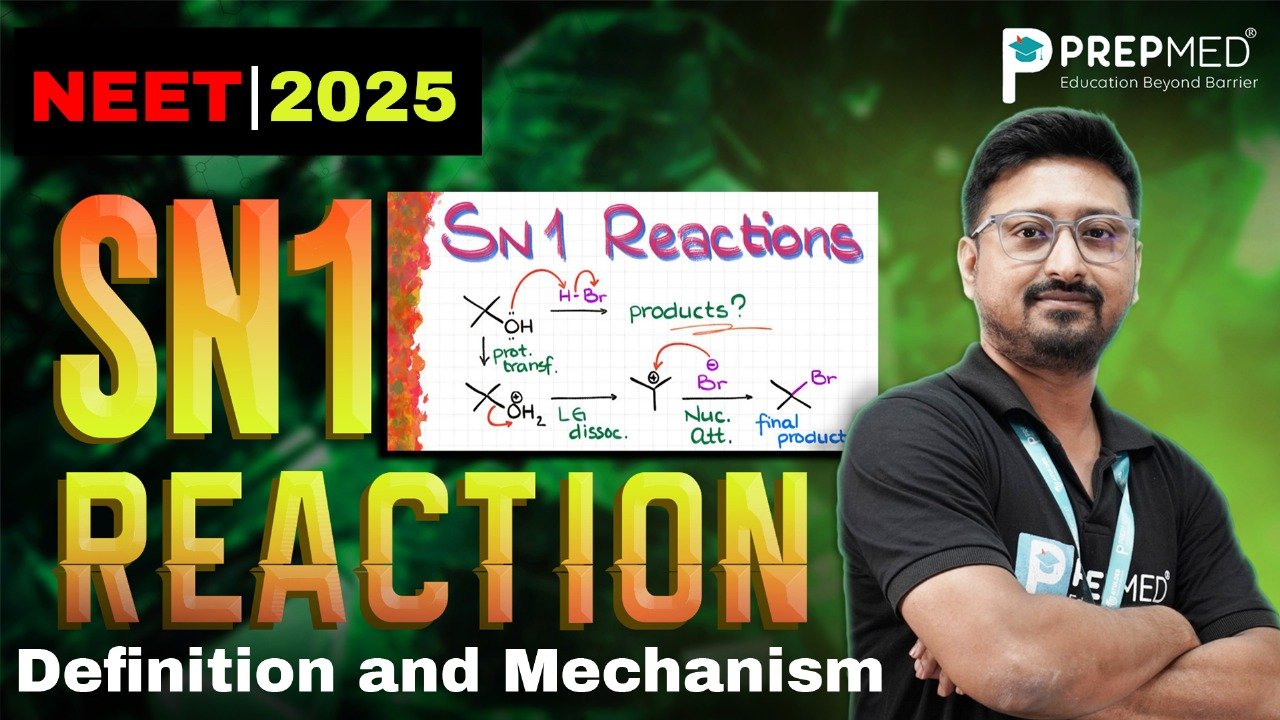March 31, 2025
Understanding SN1 Reaction: Definition and Mechanism
Organic chemistry divides its reactions into two main groups which include nucleophilic substitution reactions and electrophilic reactions. Among the nucleophilic substitutions, the SN1 reaction is a key mechanism. The abbreviation SN1 represents Substitution Nucleophilic Unimolecular, which refers to a reaction where the rate-determining step involves a single molecule. The mechanism involves two sequential steps, which require the formation of a carbocation intermediate. A complete understanding of the SN1 reaction requires examining both its definition along its mechanism.
What is the SN1 Reaction?
The SN1 reaction functions as a nucleophilic substitution reaction where carbon-leaving group bond dissociation occurs before the nucleophile attaches to the carbon. The reaction follows a two-stage mechanism while leading to the formation of an intermediate carbocation as part of the reaction. The reaction is called "unimolecular" because the rate-determining step depends on the concentration of only one reactant — the substrate (the molecule that contains the leaving group).
Mechanism of SN1 Reaction
The SN1 mechanism involves two primary steps:
1. Formation of the Carbocation:
- The rate-determining step of the SN1 reaction occurs during the first step and is the slowest.
- When the bond connecting the haloalkane substrate with its leaving group (the halide ion) dissolves, it leads to the formation of the carbocation.
- The leaving group accepts electrons, which convert the carbon atom to a positively charged carbocation.
- The stability of the carbocation plays a crucial role in determining how fast this step occurs. More stable carbocations, such as tertiary carbocations, are more likely to form and thus lead to a faster reaction.
This explains why tertiary alkyl halides undergo SN1 reactions more readily than secondary or primary ones.
2. Nucleophilic Attack: The second reaction step proceeds at a quicker rate than the initial step that creates the carbocation. The nucleophilic species donates its electron pair (e.g., water, alcohols, or halides) to attack the positively charged carbon atom. This results in the formation of a product where the nucleophile is now bonded to the carbon atom, replacing the leaving group.
The overall result of an SN1 reaction is a substitution, where the leaving group is replaced by the nucleophile.
Factors Affecting SN1 Reaction
Several factors influence the rate of an SN1 reaction. These include:
- Substrate Structure: As mentioned, tertiary carbocations are more stable than secondary and primary ones, making tertiary halides the most likely candidates for undergoing SN1 reactions. The more substituted the carbon is, the more stable the carbocation will be.
- Leaving Group: A good leaving group is essential for an SN1 reaction. Common leaving groups include halides (like chloride, bromide, and iodide), tosylate, and mesylate. These groups can easily accept an electron pair during the formation of the carbocation.
- Solvent: The solvent in which the reaction takes place can also impact the rate. Polar protic solvents (such as water or alcohols) are often preferred in SN1 reactions. These solvents help stabilize the carbocation intermediate and also assist in the dissociation of the leaving group.
- Nucleophile: Although the nucleophile doesn't directly influence the rate-determining step in an SN1 reaction, the strength of the nucleophile can affect the speed of the second step. A stronger nucleophile can more quickly attack the carbocation, leading to faster completion of the reaction.
Stereochemistry of SN1 Reaction
An interesting aspect of the SN1 reaction is its effect on the stereochemistry of the product. Since the intermediate carbocation is planar and can be attacked from either the front or the back, the product may have an inverted or retained configuration compared to the starting material. This leads to the possibility of racemization in cases where the substrate is chiral.
Example of an SN1 Reaction
A SN1 reaction example is the substitution of tert-butyl chloride with water. In this reaction, the leaving group (chloride) departs first, forming a tertiary carbocation. Water, acting as the nucleophile, then attacks the carbocation, replacing the chloride ion and forming tert-butyl alcohol as the product.
Let’s have a look at one of the sure-shot MCQs for NEET 2025:
Question:
Which statements apply to an SN1 reaction?
(I) The rate-limiting step of the reaction involves the alkyl halide and the nucleophile.
(II) The order of reactivity is methyl >1° >2° >3°.
(III) The rate-limiting step of the reaction involves only the alkyl halide.
(IV) There is an intermediate carbocation.
- I, II
- III ,IV
- I ,IV
- II ,III

The correct option is: Option 2
Conclusion
The SN1 reaction is a fundamental mechanism in organic chemistry characterized by the formation of a carbocation intermediate. Understanding the key factors that influence the rate of this reaction, such as substrate structure, leaving group quality, and solvent type, is crucial for mastering nucleophilic substitution. SN1 reactions are important in synthetic chemistry, especially when creating chiral molecules and studying reaction intermediates.
FAQs for S1 Reaction
1. What is the difference between SN1 and SN2 reactions?
The SN1 and SN2 reactions have different mechanisms. SN1 processes involve two steps that produce a carbocation intermediate, whereas SN2 reaction is a single step characterized by direct nucleophilic attack. SN1 reactions take longer to perform but SN2 reactions complete in one step.
2. Why do tertiary alkyl halides undergo SN1 reactions more easily?
Tertiary alkyl halides undergo SN1 reactions more easily because the carbocation intermediate that forms during the reaction is more stable. A tertiary carbocation is stabilized by the inductive effects of three alkyl groups, making the reaction faster compared to secondary or primary carbocations.
3. Can a strong nucleophile speed up an SN1 reaction?
No, a strong nucleophile does not influence the rate of the SN1 reaction significantly. In SN1 reactions, the rate-determining step is the formation of the carbocation, which depends on the substrate and leaving group, not on the nucleophile. However, a stronger nucleophile can speed up the second step of the reaction, where the nucleophile attacks the carbocation.







